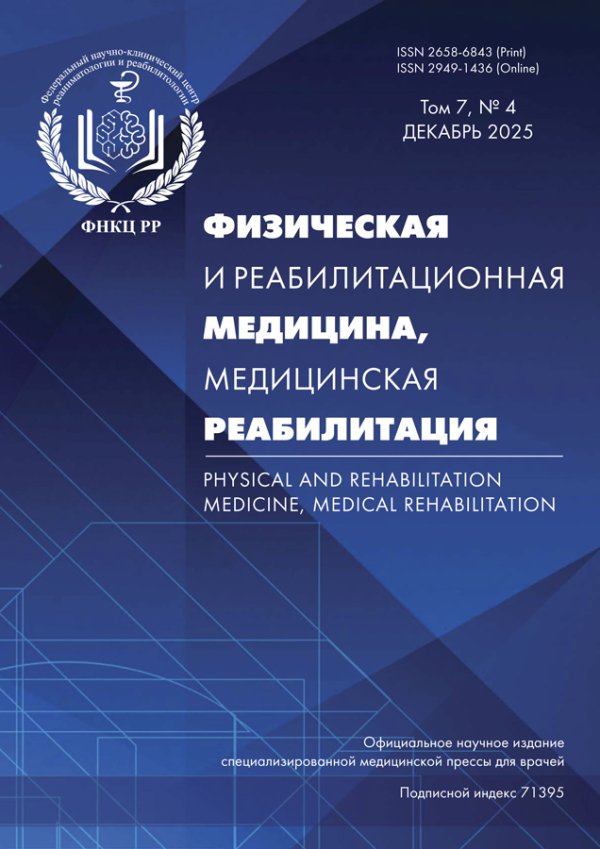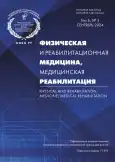Characteristics of gait function in hemiparetic patients with subacute period of ischemic stroke: a single-center retrospective study
- Authors: Skvortsov D.V.1,2,3, Grebenkina N.V.2, Kaurkin S.N.1,2, Ivanova G.E.1,2
-
Affiliations:
- Federal Center of Brain Research and Neurotechnologies
- The Russian National Research Medical University named after N.I. Pirogov
- Federal Medico-Biological Agency Federal Research Clinical Center
- Issue: Vol 6, No 3 (2024)
- Pages: 208-219
- Section: ORIGINAL STUDY ARTICLE
- URL: https://journal-vniispk.ru/2658-6843/article/view/269348
- DOI: https://doi.org/10.36425/rehab634515
- ID: 269348
Cite item
Full Text
Abstract
BACKGROUND: Gait disorders are common among 80% of stroke patients. Its consequences include increased risk of falls and functional limitations, which can significantly reduce the quality of life.
AIM: To investigate the functional profile of hemiparesis resulting from subacute ischemic stroke.
MATERIALS AND METHODS: This observational, retrospective, one-stage, single-center study analyzed primary biomechanical gait parameters in 31 patients and 34 healthy controls. Spatial, temporal, kinematic, and electromyographic characteristics were recorded. A statistical assessment and inter-group and intra-group comparison of the collected data were performed to identify the pathognomonic features of hemiplegic gait in patients with subacute stroke.
RESULTS: Changes in gait biomechanics typical for hemiparetic patients who have suffered from ischemic stroke were described: slight asymmetry of step cycle, normal duration of support period on the paretic side, significant increase in duration of support period on the healthy side, and shortening of single support period on the paretic side. Additionally, the asymmetry of the walking function was characterized by changes in reciprocity, that is, a harmonious sequence of step cycles. The function of the hip and knee joints was reduced and altered, and the amplitude of the ankle joint was increased. Decrease and change in the bioelectric activity profile of muscles were detected. Moreover, the quadriceps femoris function was least affected.
CONCLUSION: The main changes in walking function are characterized by an asymmetry of spatiotemporal parameters, a decrease in movement amplitudes of the hip and knee joints on the paretic side, an increase in ankle joint amplitude, a decrease in the bioelectric activity of muscles, and a shift in the phases of their activity. The results contribute to a better understanding of the mechanisms behind hemiplegic gait and provide a valuable tool for developing more personalized and targeted rehabilitation plans for patients suffering from hemiparesis as a result of subacute ischemic stroke.
Keywords
Full Text
##article.viewOnOriginalSite##About the authors
Dmitry V. Skvortsov
Federal Center of Brain Research and Neurotechnologies; The Russian National Research Medical University named after N.I. Pirogov; Federal Medico-Biological Agency Federal Research Clinical Center
Email: dskvorts63@mail.ru
ORCID iD: 0000-0002-2794-4912
SPIN-code: 6274-4448
MD, Dr. Sci. (Medicine), Professor
Russian Federation, 1/10 Ostrovityanova street, 117513 Moscow; 1 Ostrovityanova street, 117513 Moscow; 28, Orekhovy blvd, 115682 MoscowNatalya V. Grebenkina
The Russian National Research Medical University named after N.I. Pirogov
Author for correspondence.
Email: grebenkina_nv@rsmu.ru
ORCID iD: 0000-0002-8441-2285
SPIN-code: 6621-3836
Russian Federation, 1 Ostrovityanova street, 117513 Moscow
Sergey N. Kaurkin
Federal Center of Brain Research and Neurotechnologies; The Russian National Research Medical University named after N.I. Pirogov
Email: kaurkins@bk.ru
ORCID iD: 0000-0001-5232-7740
SPIN-code: 4986-3575
MD, Cand. Sci. (Medicine), Associate Professor
Russian Federation, 1/10 Ostrovityanova street, 117513 Moscow; 1 Ostrovityanova street, 117513 MoscowGalina E. Ivanova
Federal Center of Brain Research and Neurotechnologies; The Russian National Research Medical University named after N.I. Pirogov
Email: reabilivanova@mail.ru
ORCID iD: 0000-0003-3180-5525
SPIN-code: 4049-4581
MD, Dr. Sci. (Medicine), Professor
Russian Federation, 1/10 Ostrovityanova street, 117513 Moscow; 1 Ostrovityanova street, 117513 MoscowReferences
- Martin SS, Aday AW, Almarzooq ZI, et al. 2024 Heart disease and stroke statistics: A report of US and global data from the American Heart Association. Circulation. 2024;149(8):e347–e913. EDN: RGAVBF doi: 10.1161/CIR.0000000000001209
- Feigin VL, Brainin M, Norrving B, et al. World Stroke Organization (WSO): Global stroke fact sheet 2022. Int J Stroke. 2022;17(1): 18–29. doi: 10.1177/17474930211065917. Erratum in: Int J Stroke. 2022;17(4):478. doi: 10.1177/17474930221080343
- Ignatyeva VI, Voznyuk IA, Shamalov NA, et al. Social and economic burden of stroke in Russian Federation. S.S. Korsakov J Neurol Psychiatry. Special Editions. 2023;123(8-2):5–15. EDN: QEIVCM doi: 10.17116/jnevro20231230825
- Aqueveque P, Ortega P, Pino E, et al. After stroke movement impairments: A review of current technologies for rehabilitation. Chapter 7. In: Physical Disabilities Therapeutic Implications. 2017. Р. 95–116. doi: 10.5772/67577
- Duncan PW, Zorowitz R, Bates B, et al. Management of adult stroke rehabilitation care: A clinical practice guideline. Stroke. 2005;36(9):e100–143. doi: 10.1161/01.STR.0000180861.54180.FF
- Batchelor FA, Mackintosh SF, Said CM, Hill KD. Falls after stroke. Int J Stroke. 2012;7(6):482–490. doi: 10.1111/j.1747-4949.2012.00796.x
- Van der Kooi E, Schiemanck SK, Nollet F, et al. Falls are associated with lower self-reported functional status in patients after stroke. Arch Phys Med Rehabil. 2017;98(12):2393–2398. doi: 10.1016/j.apmr.2017.05.003
- Perry J, Burnfield JM. Gait analysis: Normal and pathological function. New Jersey: Slack Incorporated; 2010. 576 p.
- Wang Y, Mukaino M, Ohtsuka K, et al. Gait characteristics of post-stroke hemiparetic patients with different walking speeds. Int J Rehabil Res. 2020;43(1):69–75. doi: 10.1097/MRR.0000000000000391
- Skvortsov DV, Kaurkin SN, Ivanova GE, et al. Targeted walking training of patients in the early recovery period of cerebral stroke (preliminary research). J Clin Pract. 2021;12(4):12–22. EDN: BTOFFV doi: 10.17816/clinpract77334
- Almeida A do SS, Viana da Cruz AT, Candeira SR, et al. Late physiotherapy rehabilitation changes gait patterns in post-stroke patients. Biomedical Human Kinetics. 2017;9(1):14–18. doi: 10.1515/bhk-2017-0003
- Patterson KK, Gage WH, Brooks D, et al. Evaluation of gait symmetry after stroke: A comparison of current methods and recommendations for standardization. Gait Posture. 2010;31(2): 241–246. EDN: NYMQAJ doi: 10.1016/j.gaitpost.2009.10.014
- Matsuzawa Y, Miyazaki T, Takeshita Y, et al. Effect of leg extension angle on knee flexion angle during swing phase in post-stroke gait. Medicina (Kaunas). 2021;57(11):1222. doi: 10.3390/medicina57111222
- Mohan DM, Khandoker AH, Wasti SA, et al. Assessment methods of post-stroke gait: A scoping review of technology-driven approaches to gait characterization and analysis. Front Neurol. 2021;12:650024. EDN: KOBWZX doi: 10.3389/fneur.2021.650024
- Balaban B, Tok F. Gait disturbances in patients with stroke. PM R. 2014;6(7):635–642. doi: 10.1016/j.pmrj.2013.12.017
- Srivastava S, Patten C, Kautz SA. Altered muscle activation patterns (AMAP): An analytical tool to compare muscle activity patterns of hemiparetic gait with a normative profile. J Neuroeng Rehab. 2019;16(1):21. doi: 10.1186/s12984-019-0487-y
- Skvortsov DV. Diagnostics of motor pathology by instrumental methods: Gait analysis, stabilometry. Moscow: Nauchno-meditsinskaya firma MBN; 2007. 620 р.
- Kim H, Kim YH, Kim SJ, Choi MT. Pathological gait clustering in post-stroke patients using motion capture data. Gait Posture. 2022;94:210–216. EDN: KWOPRU doi: 10.1016/j.gaitpost.2022.03.007
- Wang Y, Tang R, Wang H, et al. The validity and reliability of a new intelligent three-dimensional gait analysis system in healthy subjects and patients with post-stroke. Sensors (Basel). 2022;22(23):9425. EDN: CFRYTO doi: 10.3390/s22239425
Supplementary files















